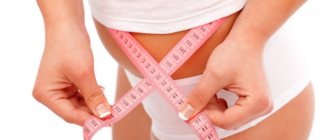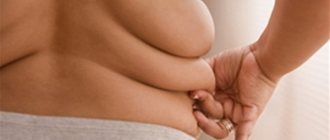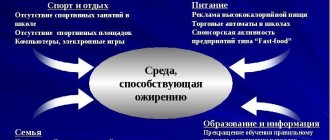Pregnancy and childbirth radically change a woman's body. The main burden falls on the stomach: it is he who must accept new life into his arms for a sufficiently long period of time, create all the conditions for its normal development. The volume of the abdomen increases due to the growing uterus, which becomes 50 times larger during the entire period of gestation! This is logical, since it must withstand the weight of the placenta (1 kg) and amniotic fluid (2 l). As the stomach grows, it pulls along the skin, muscles, ligaments, tendons - all the soft tissues located in the abdominal area.
Causes of postpartum belly
After pregnancy, the belly is in no hurry to shrink - this is the norm. Nine months is a decent amount of time to get into the physiological habit of being big. Moreover, after childbirth, a lot of lymph and blood accumulate in the abdominal cavity, which prevents the stomach from immediately becoming flat as before.
Besides:
- the uterus, according to the laws of physiology, contracts gradually over a couple of weeks, but finally comes to its senses after the entire internal surface of the organ has turned into a continuous wound, within a couple of months;
- stretched muscles of the anterior abdominal wall, which gradually regain their tone after the action of the hormone relaxin, are restored within a year;
- the skin even longer tries to acquire its usual volume, since the synthesis of its own collagen and elastin is individual for everyone, which is why a sagging belly often appears after childbirth;
- The “swelling” of the postpartum abdomen is aggravated by the hormones remaining in the form of a fat layer, which took care of the proper development of the baby, and the sedentary lifestyle of the young mother, which provokes obesity.
- Another cause of a large belly after childbirth may be diastasis - the divergence of the fibers of the aponeurosis
located between the rectus muscles of the anterior abdominal wall. The phenomenon is quite common, but in 85% of cases it disappears within a year on its own. If this does not happen, this is a reason to seek advice from a surgeon.
Features of the female physique
Many women associate the dream of a perfectly flat stomach with total weight loss. And they even begin their path to the ideal, practicing all kinds of methods for regulating body weight. The kilograms are gradually decreasing and the weight seems to be normal, but the figure still remains imperfect - the stomach does not become flat and the waist is thin. Quite natural questions arise: what is this connected with, and how to proceed?
The fact is that even with normal weight, fat deposits can be distributed unevenly. So, some thin-looking women have a fairly significant layer of fat on the abdomen, buttocks and thighs. That is why for a good figure it is not so much the ratio of weight and height that is important, but the size of the fat layer.
The normal level for a healthy woman is considered to be 23-24% fat, with 10-12% of it accumulating in the chest, buttocks, and inner thighs (trained female athletes, as a rule, have only 10-15% fat).
It is believed that it is difficult for an adult woman to achieve a figure below 17%, moreover, reducing body fat below 13% can significantly harm health.
During pregnancy, as a result of hormonal changes in the body, the fat layer increases. It must protect the fetus from external influences. This is especially true for the abdomen, so after childbirth, in addition to stretched muscles, which should return to normal over time, there remains a layer of fat on the abdomen. Because of this, it protrudes, looks uneven and ugly.
What can be done in such a situation? It is necessary to reduce the percentage of fat, while simultaneously increasing the strength of the abdominal muscles, giving them the desired shape.
Can the problem “resolve” on its own?
The answer to this question is ambiguous. It all depends on a number of points:
- firstly, it depends on whether the delivery was natural or artificial (caesarean section): with a natural delivery it is much faster;
- depending on the age of the mother: the younger, the faster the recovery;
- depending on the type of birth: after the first, the recovery process is almost ideal, but with the second and third it requires more and more effort;
- postpartum metabolism matters; the more intense it is, the faster you can get rid of fat deposits;
- finally, heredity plays a role: the constitution and structure of the skin directly affect the speed of rehabilitation.
It should be noted that breastfeeding also contributes to recovery after childbirth: with each feeding, the uterus decreases in size, and a proper diet helps natural weight loss. The rest depends on the woman’s persistence and desire to return to her previous forms.
How to remove belly fat at home
Any young mother dreams of quickly regaining her previous figure. But this should be achieved gradually, taking into account the need for proper rest, recuperation, and devoting maximum time to the baby’s health. At first, physical effort is a taboo. Walking in the fresh air and breathing exercises are enough. But after a while, which is individual for each mother, you can consistently add simple exercises, diet, self-massage, wearing a bandage, cosmetics for stretch marks and to tighten the dermis.
Exercises
Previous forms cannot be returned without physical effort. Two months after spontaneous birth or 4 months after a “caesarean section”, light but regular training with a strictly dosed load is started. Warm-up before them can be dancing or running in place.
Such physical exercises include:
- a fitball
is an excellent device for losing postpartum belly fat. This large, elastic ball will also help rock the baby, who falls asleep perfectly in his mother’s arms when she monotonously bounces on the ball, without leaving its surface. At the same time, the back muscles are toned, the spine relaxes, posture returns to normal, and the mood rises. It is important not to make a mistake when choosing a fitball. There are smooth and pimply balls, the second one additionally massages the skin of the abdomen. The fitball is selected according to size: height, minus 100;- Squats with a baby in your arms
are the joy of communicating with a baby, plus physical activity for muscle rehabilitation. Exercises are performed in any position, smoothly, slowly. Squats from a standing position are shallow; while lying down, leg swings, rolls, torso twists, and lifts are possible. The same can be done while sitting. At the same time, the vestibular apparatus of mother and baby is trained.
Bandage
To more quickly return to a flat tummy, until recently they used a sling with a wide stole, cross to cross. Today it has been replaced with compression garments and an elastic bandage. Young mothers often combine these devices: the underwear perfectly models the figure and is invisible under clothes, and the bandage - an orthopedic belt - is comfortable to wear every day at home or under outerwear in the cold. They support the abdomen and internal organs, block further muscle stretching, tone them, properly distribute intra-abdominal pressure, and stimulate uterine contraction.
- The bandage relieves the lower back and supports the spine, prevents the formation of postoperative hernias and the progression of diastasis.
Nutrition
Breastfeeding is the best way for postpartum weight loss. But in order for the milk composition to be optimal for the baby, a balanced diet is needed. Recommendations for proper food intake are known to everyone:
- fractional meals up to 6 times a day, in palm-sized portions;
- food, like feeding the baby, is strictly according to the clock;
- drink - up to 2 liters daily.
The menu includes lean meats, poultry, fish, vegetables, fruits, dairy products, cereals, vegetable and butter, and excludes foods that cause fermentation: white cabbage, turnips, radishes, grapes, apricots.
Self-massage
Regular massage of the anterior abdominal wall and sides will improve the shape of your postpartum tummy. It is done in the shower using stroking with a hard sponge (after a caesarean section, instead of a massage, they practice retracting the abdomen). The sponge can be replaced with special devices: massagers, which activate blood flow, renew epithelial cells, and restore connective tissue and muscle fibers.
Comprehensive rehabilitation program
In contrast to independent restoration of lost forms, when seeking help from a specialist, a young mother receives a comprehensive rehabilitation program, individually selected directly for her, taking into account the physiological characteristics of the body. As a rule, it includes a whole program of physical exercises, including strengthening the pelvic floor muscles, pressotherapy, radiolifting, laser and cryotherapy, special massage techniques and intimate plastic surgery (if necessary).
This alone makes you think about the benefits of vocational rehabilitation. Of course, a correct, individual approach to solving the problem will speed up the process of disappearance of the postpartum belly and give patients a great mood.
Balanced diet on an individual basis
The principles of rational nutrition, taking into account the latest achievements of aesthetic dietetics, will allow you to build your own weight loss program. To implement it you need:
- cleanse the daily menu of food waste, that is, all harmful foods: excess amounts of sweets, flour, soda, pastries, white bread. These are fast, high-calorie carbohydrates. By eating them, a young mother does not get full, but deposits excess calories at her waist, adding extra centimeters. Prohibited are sausages, semi-finished products, smoked meats, fatty meats and poultry;
- Avoid fried foods to block rapid weight gain;
- observe the principle of fractional meals;
- steam or boil or bake all food;
- consume large amounts of fiber daily: low-calorie vegetables, greens;
- calculate the optimal drinking regimen: 40 ml of water per 1 kg of weight with constant monitoring of proportions;
- consume sweets in minimal quantities: a couple of pieces of chocolate twice a week after a walk or physical activity.
The basis of nutrition for normalizing the postpartum belly is porridge, lean fish, meat, lettuce, dried fruits.
- The doctor will definitely formulate a diet in such a way as to avoid eating disorders. It will eliminate errors:
- fasting: a nursing mother cannot avoid eating for more than 6 hours;
- skipping meals: the result is sad, rapid weight loss will result in the return of lost kilograms;
- low-carbohydrate diets: weight will come off quickly, but this will cause exhaustion of the body, which is simply dangerous for a young mother;
- eating low-fat food: the skin and hormonal system will suffer with the development of amenorrhea and thyroid problems;
- non-compliance with the physical activity regime: physical activity is necessary to activate metabolism and gradual weight loss without regaining lost kilograms.
Instead of an epilogue: quickly or gradually?
Pregnancy and childbirth are quite a serious stress for the female body. Therefore, complete recovery takes time. Rapid weight loss during this period is not only unlikely, but also very dangerous. And in order not to disrupt the already somewhat weakened metabolism and not to leave the baby without mother’s milk, you need to get rid of the postpartum belly correctly and gradually.
Related posts:
Myths about diets
Rice diet for weight loss
Why can't you eat after 6 pm?
Can bacteria cause obesity? Scientists have proven that yes!
Nutrition for the elderly
Test check yourself:
fact or fiction?
Eating more fruit can improve bone density.
Correct! Wrong!
Consuming foods with plenty of bioavailable calcium improves bone density. Fruits generally do not contain much calcium.
Excess protein accumulates in the muscles, causing them to increase.
Correct! Wrong!
Once the need for protein and energy has been met, excess amino acids are converted to acetyl-CoA, from which they are converted into fatty acids and stored in adipocytes. Therefore, excess protein will not be converted into muscle.
Wraps
The problem of many women after childbirth is stretch marks on the abdomen as a result of the skin losing normal nutrition and oxygen supply. Wraps will help restore tissue - a simple procedure that, with the help of special compounds applied under the film, balances blood flow, normalizes cell nutrition and oxygen saturation. Natural ingredients are most often used as activators: algae, clay, honey, mud.
Strengthening the abdominal muscles
If we talk about the speed and safety of abdominal correction after childbirth, then swimming will be a priority for strengthening the abdominal muscles. But, more often than not, a young mother does not have enough time to visit the pool. In order to comply with the “do no harm” principle, a special set of exercises has been developed, which are performed under the supervision of a specialist:
- the side “bar” involves all the muscles of the body, like the rectus plank, but it is preferable after childbirth if there are doubts about the condition of the aponeurosis - the white line of the abdomen: the choice is up to the specialist;
- breathing exercise that trains the deep abdominal muscles - “vacuum”: stretching the abdomen as you exhale;
- pelvic lifts in a lying position without lifting the lower back from the surface;
- The well-known “scissors” and “bicycle” are also welcome (not with diastasis!);
- swinging your legs from a lying or kneeling position not only removes the stomach, but also corrects the hips and buttocks.
Later, the doctor, who monitors the progress of the correction, can connect dumbbells and an expander.
Professional massage
The basis of the entire comprehensive rehabilitation program for the anterior abdominal wall after childbirth is massage. For comparison: muscles after natural childbirth come to their senses over the course of 8 months or a year. Massage along with exercise and a balanced diet speeds up the process by half due to contact toning of the abdominal muscles and activation of blood supply to the tissues.
- However, the procedure also has contraindications:
- infections in the acute period, including viral ones, influenza;
- exacerbation of somatic diseases;
- pyoderma (pustular rashes);
- violation of skin integrity;
- tumors;
- allergy;
- dyspepsia during the last few days;
- mental disorder;
- recent operations (less than a month ago).
Abdominal massage after childbirth is an excellent opportunity not only to correct your figure, but also to relax, balance your intestines, and overcome postpartum depression, fatigue, and lack of sleep. Specialists at aesthetic cosmetology centers use different techniques: classical, relaxing, lymphatic drainage, vacuum. Have a massage after a small snack. If you have a big lunch, you should wait two hours.
Any discomfort during the session is a reason to stop the procedure. The massage technique is standard: start with light strokes with a gradual increase in amplitude. Then they add pushes and move clockwise in a circular motion from the sides to the center. If there are local fat compactions or the thickness of the fat fold is significant in itself, kneading is used. Many massage therapists use the technique of “sawing” the anterior abdominal wall with the edge of the palm. The massage ends with the same strokes. Thus, activation of blood flow and metabolism is achieved, that is, all conditions are created for the restoration of previous forms.
If classic manual massage is not enough, hardware techniques are added. In exceptional cases, we can talk about abdominal plastic surgery.
A set of exercises that can be successfully done at home.
Before classes, before and after, it is advisable not to eat for an hour. Any complex must begin with warm-up and stretching. Turn on some nice music, dance a little, warm up, stretch the muscles of your neck, arms and back, stretch your leg muscles. And start exercising.
- We stand straight, legs together, starting to squat, move our buttocks back strongly, tilt our body and place our hands on the middle of our thighs. (You cannot lift your heels off the floor.) Inhale and round your stomach. We begin to straighten our back and raise our arms up, while exhaling and drawing in our stomach. Then we return to the starting position and start the exercise again, repeating about 5 times, gradually increasing the delay time and the number of approaches.
- Lying on your back, place your arms along your body, bend your legs slightly and spread them wide, with your lower back pressed to the floor. Now, as you exhale, we pull in the stomach, understand the pelvis and hold this position for 30 seconds. Do a couple of approaches at first, and over time try to increase the number and time of execution.
- Bring your knees to your chest while lying on your back. Spread your arms and press your palms to the floor. Lift your buttocks and rotate your hips to the side (to the left), while keeping your knees closed and your shoulders motionless. Hold and count to 10 (then increase the time), move your hips to the starting position and then move in the other direction.
- Lying on your back, hands behind your head, legs bent, feet on the floor. We stretch our arms forward, while trying to strain not the neck, but the abdominal muscles and do not move the head. Stay in this state, count to 10. Do the exercise at first no more than five times, as your endurance increases, increase the number of approaches.
Remember the baby does not limit you, all barriers are in your head
How to remove belly fat with diastasis
When the aponeurosis of the longitudinal abdominal muscles diverges, all standard methods for correcting curvy figures are not suitable. You can remove fat, but the belly will still stick out, since there is nothing to support the muscles in their normal position. Only a doctor knows what to do in this case. Gymnastics is possible only with the mildest degree of diastasis. In other cases, an operation is needed: suturing the resulting discrepancy.
Did you find this article helpful? Subscribe to our newsletter to receive a weekly digest of the materials we publish, as well as learn about our news and promotions.
If you have any questions, leave a comment on social networks, and our specialists will definitely answer.
When will the results be noticeable?
If you follow the recommendations, after 1.5-2 months the abdominal muscles will become stronger and will be able to support the abdominal wall well. Working on the abdominal muscles, in addition to a flat stomach, will also provide you with an elegant thin waist, for which the same muscles are largely responsible.
But this does not mean that we can now forget about them. Only regular maintenance exercises will help maintain and improve the results obtained. Remember that a flat stomach is a lifestyle, not a one-time promotion that will provide you with it for life.










